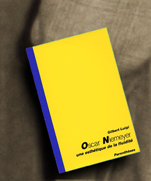The relations between painting and architecture span several thousand years. Yet they remain highly complex, since they vary with the times, with the artists involved and the techniques used, with the way they work together, and with the artistic conceptions that converge with or diverge from these two “arts of space” as Henri van Lier calls them.
We know, for example, that the new architecture that appeared in Italy during the Renaissance, began as simply painted representations, before transforming into actual building commissions.
Contrary to what may be thought, though landscape is a pictorial genre that stands alone or develops jointly with other genres, only very few painters have ever chosen a single building as the subject of their picture, making a "portrait" of the building rather than weaving it as a motif into a landscape.
William Turner achieved this with his L’Hôtel de Ville in Paris or the Château d’Amboise, painted during his journey to France in 1802. And Vincent van Gogh also ‘portrayed’ a number of the buildings in which he lived at different times in his life, from the Nuenen period in 1885 right up to his death in Auvers-sur-Oise in 1890.
Yet clearly the most striking and complex experiment in this field is the famous series of thirty canvases that Claude Monet painted of Rouen Cathedral between 1892 and 1894. Georges Clémenceau wrote of these works that “seen together, (they) represent a particular moment of art” (1895). In 1929, Kazimir Malevich accurately wrote that “Monet was working above all on the changes in the purely physical aspect of light, not on Rouen Cathedral as such.”
© Jacques Benoit. Design, works, photographies and texts by Jacques Benoit and under the author’s copyright. Except when derived from other sources and then mentioned as such.
